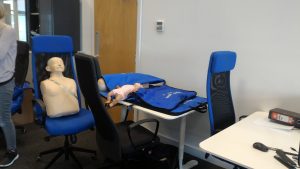I have bought my third umbrella here in Belfast. Looking at the numbers (1 umbrella/2 weeks) this might be the last one I need. But in the end it’s all up to the wind scale. Belfast, how do feel about making a deal with me? I’ll take one more hour of rain a day (the difference won’t be notable but psst!) and you are getting rid of your windy attitude! Let’s make these last two weeks wind free!
Have you heard the mysterious abbreviation of the title before? D.R. might indicate something medical, right? Bingo. Yesterday the company employees completed a first aid course. Who would have thought that my internship would include a first aid training? It was surprising for me as well, as I was informed about it one hour before it started. I did three or four first aid courses back in Germany, the last happened two years ago as part of my current training. To be honest, I didn’t remember much about those classes. What I immediately recognised where the dummies. Good to know, that they are equally horrifying here in Northern Ireland. There was also a baby mannequin (even more horrifying), which would later teach us how to act when babies are choking.

But the main focus of the course was D.R.S.A.B.C. What should we do, if we see a collapsed person on the ground?
D = Danger. Assess your surroundings. Be assured that your own safety isn’t threatened. Is there anything dangerous around the collapsed? If yes, try to fix the surroundings. Move anything dangerous away, move the person only if totally necessary.
R = Response. Get close to the person, ask the person loudly (but no shouting) if they can hear you. If there is no response, shake the person lightly by his or her shoulders.
S = Shout. Shout not at the person, but at the people who are possibly around. You have better chances at a very public place. If a person reacts to your shouting and comes up to you, you tell him to call 999 (112). If there is no one that can assist you, call the ambulance yourself as of right now. Be quick, answer the important questions: What & Where? Don’t make a diagnosis.

A = Airway. Ensure that the airway of the person is not blocked.
B = Breathing. Check whether the person is breathing, if he isn’t the final step has to be taken…
C = CPR. Cardiopulmonary resuscitation. 30 chest compressions, a maximal depth of 5 centimetre to the beat of „Stayin’ Alive“ (if that’s not ironic, what is?) and afterwards two mouth-to-mouth exhales. Repeat the procedure until the ambulance arrives or the patient breathes again.
This is D.R.S.A.B.C and I think I am actually going to remember this. It’s catchy. We talked a lot about heart attacks, about the causes and its effects. There is a common mistake made in this context. Heart attack is not the same as a cardiac arrest. A cardiac arrest is a follow-up of a heart attack. Both cases are treated differently.
And that was the compressed insight into first aid. You never know if it might be helpful one day!